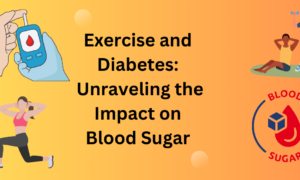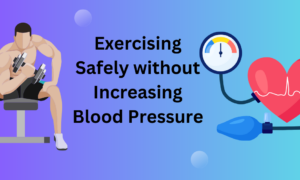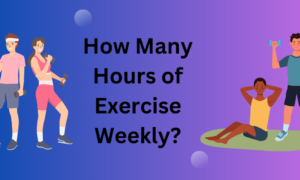Welcome to our blog post on exercises to lower your blood sugar! If you’re looking for practical and effective ways to manage your blood sugar levels, then you’ve come to the right place. Understanding how blood sugar affects your body is key to taking control of your health. In this article, we’ll explore the link between exercise and blood sugar levels, as well as share some types of exercises that can help lower them. We’ll also provide tips on incorporating exercise into your daily routine and discuss other lifestyle changes that can complement your efforts. So let’s dive in and discover how staying active can make a significant difference in managing your blood sugar levels!
In This Article
Understanding Blood Sugar and Its Effects on the Body

Blood sugar, also known as glucose, is a type of sugar that circulates in our bloodstream. It serves as the primary source of energy for our cells and organs, playing a crucial role in maintaining our overall health and well-being.
When we consume carbohydrates or sugars through food and drinks, they are broken down into glucose during digestion. This glucose then enters the bloodstream, causing blood sugar levels to rise. In response to this increase in blood sugar, the pancreas releases insulin – a hormone that helps transport glucose from the bloodstream into cells.
For people with diabetes or individuals who struggle with high blood sugar levels, this process may not function properly. Insufficient insulin production or resistance to its effects can lead to elevated blood sugar levels over time. If left unmanaged, consistently high blood sugar can have serious consequences on various body systems.
One immediate effect of high blood sugar is increased thirst and frequent urination. Excessive thirst occurs because your body tries to flush out excess glucose through urine. Additionally, you may experience fatigue due to inadequate delivery of energy to your cells.
Long-term complications include damage to vital organs such as the heart, kidneys, eyes, and nerves. High blood sugar can lead to cardiovascular diseases like heart attacks and strokes due to plaque buildup in arteries caused by persistently elevated glucose levels.
Moreover, the kidney’s ability to filter waste products effectively gets compromised when exposed continuously to excessive amounts of glucose.
This can lead to kidney disease and even kidney failure if not managed promptly.
Highbloodsugaralsodamages tiny blood vessels in the eyes, resulting in retinopathy and potentially leading to vision loss.
In addition, blood vessel damage can cause peripheral neuropathy, numbness, and tingling sensations in the extremities, such as the hands and feet.
Well-controlled blood sugar levels are essential for reducing the risk of these complex complications.
Exercises To Lower Your Blood Sugar: The Link Between Exercise and Blood Sugar Levels
Regular exercise has been shown to have numerous benefits for our overall health and well-being. One of the key ways that exercise can make a positive impact is by helping to regulate blood sugar levels.
When we engage in physical activity, our muscles require energy. This energy comes from glucose, which is the primary source of fuel for our bodies. As we exercise, our muscles use up this glucose, resulting in a decrease in blood sugar levels.
Furthermore, regular physical activity can also improve insulin sensitivity. Insulin is a hormone that helps transport glucose into cells for energy production. By increasing insulin sensitivity through exercise, our cells become more efficient at absorbing and utilizing glucose.
Not only does exercise lower blood sugar levels during the activity itself but it also has long-term effects on managing blood sugar levels throughout the day. Regular physical activity can help improve overall glycemic control and reduce the risk of developing type 2 diabetes.
The type and intensity of exercises play a significant role in their effect on blood sugar levels. Aerobic exercises such as brisk walking, jogging, or cycling are particularly effective at lowering blood sugar because they increase heart rate and respiration rates, leading to greater energy expenditure.
Strength training exercises like weightlifting or resistance band workouts are also beneficial as they increase muscle mass and promote better utilization of glucose throughout the body.
It’s important to note that individual responses may vary when it comes to how much an individual’s blood sugar level drops after exercising or what type of exercise works best for them. It’s always advisable to consult with a healthcare professional before starting any new exercise routine.
Incorporating regular physical activity into your daily routine not only helps manage blood sugar levels but also provides numerous other health benefits such as improved cardiovascular fitness, weight management, and stress reduction.
So why wait? Lace-up those sneakers and find an enjoyable form of exercise that suits you – your body will thank you!
Types of Exercises That Can Help Lower Blood Sugar
Exercise is a powerful tool when it comes to managing blood sugar levels. Not only does it help improve insulin sensitivity, but it also aids in weight management and overall cardiovascular health. There are various types of exercises that can effectively lower blood sugar levels.
Aerobic exercises such as walking, running, cycling, or swimming are great options. These activities get your heart pumping and increase your breathing rate, helping to burn glucose for energy. Aim for at least 30 minutes of moderate-intensity aerobic exercise most days of the week.
Strength training exercises should also be incorporated into your routine. Lifting weights or using resistance bands can help build muscle mass, which improves insulin sensitivity and helps regulate blood sugar levels more efficiently. Focus on working all major muscle groups two to three times a week.
Additionally, high-intensity interval training (HIIT) has shown promising results in lowering blood sugar levels rapidly. This involves short bursts of intense exercise followed by brief periods of rest or lower-intensity activity. HIIT workouts can be adapted to different fitness levels and can provide significant benefits in a shorter amount of time.
Don’t forget about flexibility exercises like yoga or stretching. These activities not only promote relaxation but also contribute to better circulation and improved insulin function.
Remember that any form of physical activity is beneficial in lowering blood sugar levels; find what you enjoy doing and make it a regular part of your routine!
Tips for Incorporating Exercise into Your Daily Routine
Finding time to exercise can be challenging, especially when you have a busy schedule. However, incorporating exercise into your daily routine is crucial for managing blood sugar levels and promoting overall health. Here are some tips to help you make exercise a regular part of your day.
Start small. Begin with short bursts of physical activity throughout the day. Take the stairs instead of the elevator or go for a brisk walk during your lunch break. These small actions can add up and make a significant difference in lowering your blood sugar.
Find activities that you enjoy. It’s easier to stick to an exercise routine if it doesn’t feel like a chore. Whether it’s dancing, swimming, cycling, or playing sports – choose something that brings you joy and makes you want to move more.
Set realistic goals. Don’t push yourself too hard right from the beginning as this may lead to burnout or injury. Start with achievable targets and gradually increase the intensity and duration of your workouts over time.
Additionally, enlist support from friends or family members who share similar fitness goals. Exercising together not only provides accountability but also makes workouts more enjoyable and motivating.
Furthermore, prioritize consistency over intensity. Regular exercise has more long-term benefits than sporadic intense workouts once in a while. Aim for at least 30 minutes of moderate-intensity aerobic activity most days of the week.
Moreover, mix up your exercises to keep things interesting and prevent boredom from setting in. Try different types of workouts such as strength training exercises using resistance bands or bodyweight movements like squats and lunges.
Lastly but importantly, schedule dedicated workout times in advance on your calendar just as you would any other appointment or commitment; treat it as a non-negotiable time reserved solely for taking care of yourself.
Incorporating exercise into your daily routine requires planning and commitment but is well worth it for the positive impact it can have on your blood sugar levels and overall well-being
Other Lifestyle Changes That Can Help Manage Blood Sugar
In addition to exercise, several other lifestyle changes can help manage blood sugar levels. These changes may not only improve your overall health but also have a positive impact on your blood sugar control.
Maintaining a healthy diet is crucial. Focus on incorporating whole foods such as fruits, vegetables, lean proteins, and whole grains into your meals. Avoid processed and sugary foods as much as possible. Opt for low-glycemic index foods that don’t cause a rapid increase in blood sugar levels.
Another important aspect is managing stress levels. Chronic stress can lead to elevated blood sugar levels due to the release of stress hormones like cortisol. Engage in activities that help you relax and unwind such as yoga, meditation or deep breathing exercises.
Adequate sleep is also essential for managing blood sugar levels effectively. Lack of sleep can disrupt hormone balance and impair insulin sensitivity, leading to increased blood sugar levels. Aim for 7-8 hours of quality sleep each night.
Furthermore, staying hydrated plays a significant role in regulating blood sugar levels. Drinking enough water throughout the day helps prevent dehydration and supports proper kidney function which aids in glucose regulation.
It’s important to avoid smoking and limit alcohol consumption if you want to manage your blood sugar effectively. Both smoking and excessive alcohol intake can negatively affect insulin sensitivity and contribute to higher blood sugar levels over time.
By implementing these lifestyle changes alongside regular exercise routines discussed earlier, individuals with high or unstable blood sugars may experience better control over their condition while also improving their overall well-being. Remember always consult with a healthcare professional before making any drastic changes!
Consultation with a Healthcare Professional
When it comes to managing your blood sugar levels, consulting with a healthcare professional is essential. A healthcare professional, such as a doctor or registered dietitian, can provide personalized advice and guidance based on your individual needs and medical history.
During a consultation, the healthcare professional will evaluate your current blood sugar levels and discuss any symptoms or concerns you may have. They will also review your lifestyle habits, including diet and exercise routines, to identify areas for improvement.
Based on this information, the healthcare professional can create a customized plan to help you lower your blood sugar levels. This may include dietary recommendations, medication adjustments (if necessary), and most importantly, an exercise plan tailored to your abilities and preferences.
In addition to providing specific exercises that are beneficial for lowering blood sugar levels, they can also offer tips on how to safely incorporate physical activity into your daily routine. They can advise on proper form and technique during workouts to prevent injury while maximizing the benefits of exercise.
Regular follow-up appointments with the healthcare professional are crucial for monitoring progress and making any necessary adjustments along the way. These check-ins allow them to assess whether the current treatment plan is effectively managing blood sugar levels or if modifications need to be made.
Remember that each person’s body is unique in how it responds to exercise and other lifestyle changes. Therefore it is important not only consult with a healthcare professional but also keep them updated on any changes or challenges faced during the process so they can provide ongoing support throughout your journey towards healthier blood sugar management.
By working closely with a qualified healthcare professional who specializes in diabetes management or nutrition-related matters you’ll receive expert guidance tailored specifically for you – setting yourself up for success in achieving optimal blood sugar control!
Conclusion
Managing blood sugar levels is crucial for overall health and well-being, especially for individuals with diabetes. Exercise can play a significant role in controlling blood sugar levels and reducing the risk of complications associated with high blood sugar.
By understanding how exercise affects your body and incorporating different types of exercises into your daily routine, you can effectively lower your blood sugar levels. Remember to consult with a healthcare professional before starting any new exercise program, as they will provide personalized recommendations based on your specific needs and health condition.
In addition to regular physical activity, other lifestyle changes such as following a healthy diet, getting enough sleep, managing stress levels, and taking prescribed medications are also vital for maintaining stable blood sugar levels.
So why wait? Start incorporating these exercises into your daily routine today! Take control of your health by staying active and making positive lifestyle choices. Your body will thank you for it!
Remember that consistency is key when it comes to managing blood sugar levels through exercise. Stay committed to leading an active lifestyle, monitor your progress regularly, make adjustments when necessary, and celebrate small victories along the way.
With determination and dedication, you can achieve better control over your blood sugar levels while improving overall fitness. Get moving towards better health now!





















